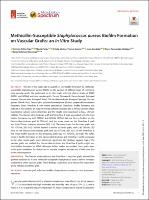| dc.contributor | Vall d'Hebron Barcelona Hospital Campus |
| dc.contributor.author | Fernández-Hidalgo, Nuria |
| dc.contributor.author | Bellmunt-Montoya, Sergi |
| dc.contributor.author | Palau Gauthier, Marta |
| dc.contributor.author | Muñoz, Estela |
| dc.contributor.author | Gomis Rodriguez, Javier |
| dc.contributor.author | Gavaldà, Joan |
| dc.date.accessioned | 2023-06-27T09:33:00Z |
| dc.date.available | 2023-06-27T09:33:00Z |
| dc.date.issued | 2023-02-07 |
| dc.identifier.citation | Tello-Díaz C, Palau M, Muñoz E, Gomis X, Gavaldà J, Fernández-Hidalgo N, et al. Methicillin-Susceptible Staphylococcus aureus Biofilm Formation on Vascular Grafts: an In Vitro Study. Microbiol Spectr. 2023 Feb 7;11(2):e0393122. |
| dc.identifier.issn | 2165-0497 |
| dc.identifier.uri | https://hdl.handle.net/11351/9903 |
| dc.description | Staphylococcus aureus; Biofilm; Infection |
| dc.description.abstract | The aim of this study was to quantify in vitro biofilm formation by methicillin-susceptible Staphylococcus aureus (MSSA) on the surfaces of different types of commonly used vascular grafts. We performed an in vitro study with two clinical strains of MSSA (MSSA2 and MSSA6) and nine vascular grafts: Dacron (Hemagard), Dacron-heparin (Intergard heparin), Dacron-silver (Intergard Silver), Dacron-silver-triclosan (Intergard Synergy), Dacron-gelatin (Gelsoft Plus), Dacron plus polytetrafluoroethylene (Fusion), polytetrafluoroethylene (Propaten; Gore), Omniflow II, and bovine pericardium (XenoSure). Biofilm formation was induced in two phases: an initial 90-minute adherence phase and a 24-hour growth phase. Quantitative cultures were performed, and the results were expressed as log10 CFU per milliliter. The Dacron-silver-triclosan graft and Omniflow II were associated with the least biofilm formation by both MSSA2 and MSSA6. MSSA2 did not form a biofilm on the Dacron-silver-triclosan graft (0 CFU/mL), and the mean count on the Omniflow II graft was 3.89 CFU/mL (standard deviation [SD] 2.10). The mean count for the other grafts was 7.01 CFU/mL (SD 0.82). MSSA6 formed a biofilm on both grafts, with 2.42 CFU/mL (SD 2.44) on the Dacron-silver-triclosan graft and 3.62 CFU/mL (SD 2.21) on the Omniflow II. The mean biofilm growth on the remaining grafts was 7.33 CFU/mL (SD 0.28). The differences in biofilm formation on the Dacron-silver-triclosan and Omniflow II grafts compared to the other tested grafts were statistically significant. Our findings suggest that of the vascular grafts we studied, the Dacron-silver-triclosan and Omniflow II grafts might prevent biofilm formation by MSSA. Although further studies are needed, these grafts seem to be good candidates for clinical use in vascular surgeries at high risk of infections due to this microorganism.
IMPORTANCE The Dacron silver-triclosan and Omniflow II vascular grafts showed the greatest resistance to in vitro methicillin-susceptible Staphylococcus aureus biofilm formation compared to other vascular grafts. These findings could allow us to choose the most resistant to infection prosthetic graft. |
| dc.language.iso | eng |
| dc.publisher | American Society for Microbiology |
| dc.relation.ispartofseries | Microbiology Spectrum;11(2) |
| dc.rights | Attribution 4.0 International |
| dc.rights.uri | http://creativecommons.org/licenses/by/4.0/ |
| dc.source | Scientia |
| dc.subject | Biofilms |
| dc.subject | Vasos sanguinis - Empelts |
| dc.subject | Malalties bacterianes |
| dc.subject | Infecció |
| dc.subject | Pròtesis |
| dc.subject.mesh | Vascular Grafting |
| dc.subject.mesh | Prosthesis-Related Infections |
| dc.subject.mesh | Biofilms |
| dc.title | Methicillin-Susceptible Staphylococcus aureus Biofilm Formation on Vascular Grafts: an In Vitro Study |
| dc.type | info:eu-repo/semantics/article |
| dc.identifier.doi | 10.1128/spectrum.03931-22 |
| dc.subject.decs | injerto vascular |
| dc.subject.decs | infecciones relacionadas con prótesis |
| dc.subject.decs | biopelículas |
| dc.relation.publishversion | https://doi.org/10.1128/spectrum.03931-22 |
| dc.type.version | info:eu-repo/semantics/publishedVersion |
| dc.audience | Professionals |
| dc.contributor.organismes | Institut Català de la Salut |
| dc.contributor.authoraffiliation | [Tello-Díaz C] Department of Vascular and Endovascular Surgery, Hospital de la Santa Creu i Sant Pau, Institute of Biomedical Research (II-B Sant Pau), CIBER CV, Barcelona, Spain. Departament de Cirurgia i Ciències Morfològiques, Universitat Autònoma de Barcelona, Bellaterra, Spain. [Palau M, Gomis X, Gavaldà J] Laboratori de Resistència Antimicrobiana, Vall d’Hebron Institut de Recerca (VHIR), Barcelona, Spain. Servei de Malalties Infeccioses, Vall d'Hebron Hospital Universitari, Barcelona, Spain. Servei de Malalties Infeccioses, Vall d’Hebron Hospital Universitari, Barcelona, Spain. Universitat Autònoma de Barcelona, Bellaterra, Spain. [Fernández-Hidalgo N] CIBER de Enfermedades Infecciosas (CIBERINFEC), Instituto de Salud Carlos III (ISCIII), Madrid, Spain. Servei de Malalties Infeccioses, Vall d’Hebron Hospital Universitari, Barcelona, Spain. Universitat Autònoma de Barcelona, Bellaterra, Spain. Red Española de Investigación en Patología Infecciosa (REIPI RD16/0016/0003), Instituto de Salud Carlos III, Madrid, Spain. [Bellmunt-Montoya S] Departament de Cirurgia i Ciències Morfològiques, Universitat Autònoma de Barcelona, Bellaterra, Spain. Laboratori de Resistència Antimicrobiana, Vall d’Hebron Institut de Recerca (VHIR), Barcelona, Spain. Servei de Malalties Infeccioses, Vall d'Hebron Hospital Universitari, Barcelona, Spain. CIBER de Enfermedades Infecciosas (CIBERINFEC), Instituto de Salud Carlos III (ISCIII), Madrid, Spain. Servei d’Angiologia, Cirurgia Vascular i Endovascular, Vall d’Hebron Hospital Universitari, Barcelona, Spain |
| dc.identifier.pmid | 36749062 |
| dc.identifier.wos | 000937345400001 |
| dc.rights.accessrights | info:eu-repo/semantics/openAccess |

 Private area
Private area Contact Us
Contact Us







